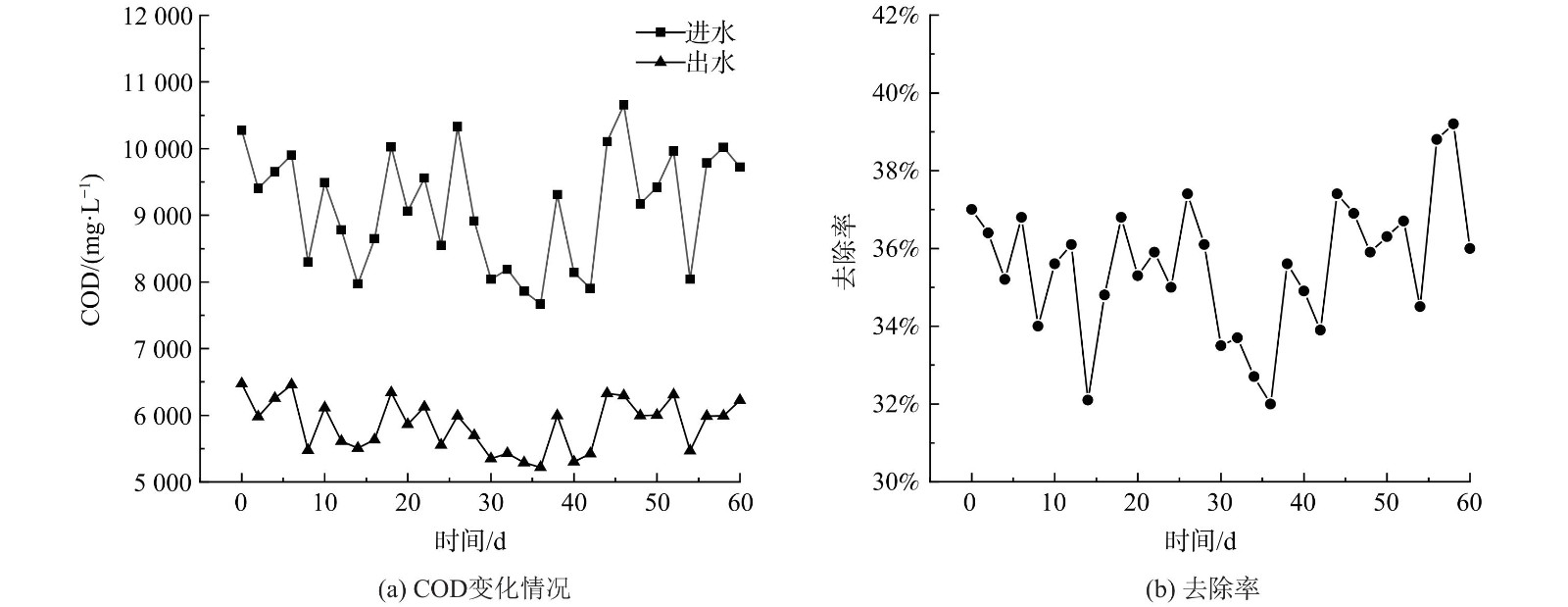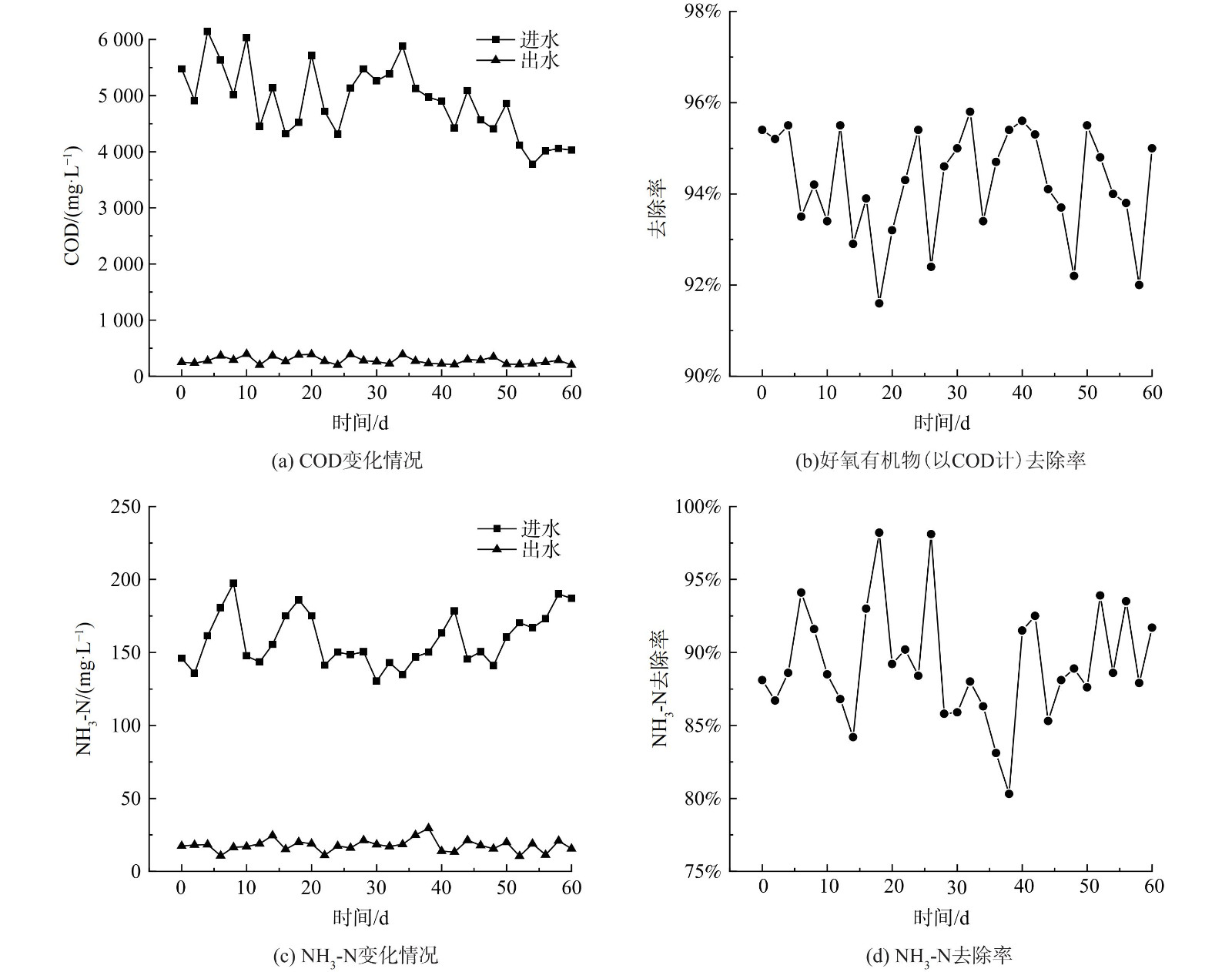-
医药企业生产废水即制药废水,呈现成分杂、毒性大、浓度高的特点[1]。高浓度制药废水的处理工艺多选用物化混凝、Fenton法、O3氧化法为预处理单元,以增加可生化性,并将其中的中大分子有机物转化为小分子物质[2-3]。黄发明[4]利用Fenton法预处理高浓度制药废水实现了有机物 (以COD计) 的去除率32.13%~41.70%。相关企业的生化处理单元以A2/O或多级A/O为主,目在于保证系统的脱氮效率[5]。沈浙萍等[6]多级A/O法处理高浓度制药废水,出水氨氮指标小于35 mg·L−1。多数制药企业后端采用膜处理单元,以满足废水中有机物的去除,提高出水水质[7]。膜处理单元多为MBR膜,通过MBR膜截留活性污泥以增加污泥停留时间,从而达到提质目标。
基于以上研究背景,针对上海某制药工厂产生高浓度难降解有机废水的水质特性,采用预处理+A3/O+MBR+RO组合工艺处理高浓度制药废水,设计规模为150 m3·d−1,实际运行处理水量125~140 m3·d−1。该工艺核心流程有预处理单元、生化处理单元与膜单元3部分。在预处理单元设计多相催化氧化工艺替代传统工艺的Fenton法;在生化处理单元的常规A2/O工艺前端,设计预缺氧单元以构建A3/O单元,以降低溶解氧指标,保证生化单元脱氮除磷效果;后段设计MBR膜单元及RO膜设备以提高出水水质。该组合工艺在设计上以降低设备与运行药剂成本和保证脱氮除磷工艺效果双重要求为目标,可为高浓度制药废水工艺实现减污降碳优化提供参考。
-
上海市某制药企业主要生产特色原料药、配套制剂及制药中间体等产品,应用于神经类药物与抗癌类药物领域。根据制药工艺将该企业生产废水分为3类:车间工艺生产的高浓度母液类、残次品有机废水;反应釜设备洗涤废水;低浓度生产废水。该车间生产工艺中高浓母液类来水水质成分复杂,含有高浓度的苯酚成分。本项目设计处理规模为150 m3·d−1;采用预处理+A3/O+MBR+RO组合工艺进行处理;排出水质执行上海市地方污染物标准《污水综合排放标准》 (DB31/199-2018) 的三级标准和《污水排入城镇下水道水质标准》 (GB/T31962-2015) 的B级标准;出水进入纳管排放。
-
该制药企业生产废水及生活污水 (后将该混合废水统称为“废水”) 共约150 m3·d−1,其中高浓度有机废水为6 m3·d−1,焚烧炉蒸馏洗涤废水20 m3·d−1,低浓度废水包括设备冲洗、生活污水共115 m3·d−1。该工艺的进水水质指标及纳管排放执行上海市地方标准 (表1) 。由于现场原水几乎不含磷,故本研究未对相关指标进行监测。
-
根据该制药企业生产工艺中各类废水特性,并结合设计处理工艺的运行成本与去除效果。由于该类制药企业生产废水中苯酚含量高,具有杀菌抑菌作用,会影响生化系统微生物发挥作用;进生化系统前的COD负荷比较高,对生化系统会造成较大冲击;废水的可生化性差,BOD5/COD约为0.1,难生化降解。因此,对该废水采用以预处理段为辅,生化处理段为主的方式,采用预处理+A3O+MBR+RO的组合工艺路线。该废水处理系统工艺流程如图1所示。
具体流程如下:1) 工艺生产中高浓度有机废水收集到高浓度调节池I,预先进入多相催化氧化预处理单元进行预处理,以改变废水中苯环结构及毒性,提高废水的可生化性,也初步降低废水中COD;2) 与反应釜洗涤废水在收集调节II充分混合,进入到混凝反应池,在混凝反应池加入一定量药剂后,进入物化沉淀池,沉淀后的废水进入生化处理段,在生化单元可通过微生物降解废水中绝大部分的COD和NH3-N;3) 再通过溢流的方式进入MBR膜单元,MBR出水进到RO反渗透设备,浓水回流到兼氧池,清水到清水池达标排放。4) 由于RO运行成本比较高,实际运行中根据出水水质情况来决定是否开启RO设备,也为MBR出水增加了把关措施。MBR膜池中产生的剩余污泥与物化沉淀池中沉淀一并打入污泥浓缩池,经浓缩和板框压滤后形成泥饼,再进行低温烘干后外委处理。
-
1) 废水预处理单元。该制药工艺车间排出的高浓度有机废水,经调节池pH调整为8~10,再通过氟塑料离心泵打到多相催化氧化反应器。在特殊催化剂催化增效的作用下,利用通入臭氧的强氧化性将废水中的大分子有机物分解转化成小分子有机物,如有机酸、醇类等,从而转变成生物易降解的物质。同时,还可分解废水中的链式不饱和化合物与杂环状化合物等有机污染物,使其双键断裂,从而破坏苯环状化合物、去除难降解的COD, 提升废水的BOD5/COD。计算得到该废水原水BOD5/COD小于0.1,后通过催化氧化反应器废水BOD5/COD提升至0.27。采用多相催化氧化反应器优势在于不产泥、不产盐,绿色无二次污染。反应器中还安装了改性活性炭,以期对高浓度有机废水起到脱色作用[8-9]。高浓度有机废水经多相催化氧化反应器的出水与反应釜洗涤废水充分混合后进入混凝反应器。在混凝反应器中投加一定比例的PAM与PAC,对废水进行预处理絮凝沉淀后进入物化沉淀池进一步沉淀,静置沉淀后将上层清液溢流至生化处理单元。
2) 废水生化系统单元。在厌氧生化池单元前端增加一个预缺氧段,便于提高生化阶段的脱氮除磷效果。针对此类难降解废水,筛选高效脱氮除磷微生物菌种,并利用细胞固定化技术,将菌种固定在特殊载体上起到菌种缓释功能,以减少有机物的冲击影响。将菌剂投放固定在各生化池中,稳定提高各生化单元的菌种数量和活性,从而增强有机物质的去除效果。为保持厌氧池的温度不低于29 ℃,将厂区锅炉蒸汽余热通入厌氧池。废水在厌氧微生物的作用下,原水中COD负荷大大降低,从而利于后续好氧池的生化。在好氧生化池中,预置投放好氧微生物菌种载体,并采用射流装置的曝气方式,加速菌种与有机物的传质效率,从而达到高效降低废水中COD、NH3-N的目标。好氧生化池的硝化混合液可通过离心泵回流到缺氧生化池当中,以提高生物脱氮除磷的效率[9-10]。
3) 复合深度膜处理单元。经好氧生化处理单元后,废水溢流到MBR膜池,在膜池中继续曝气处理,通过MBR膜分离设备将好氧池来水中的活性污泥和大分子有机物截留。同时,通过满足水力停留时间与污泥停留时间的分别调控,可保持膜池中的微生物数量,并通过离心泵,将降截留下来的活性污泥回流到好氧段,以提高有机污染物的去除效率。难降解污染物质可继续在反应器当中不断降解,也增强了对废水中有机物 (以COD计) 和NH3-N 的深度处理,从而保证出水水质[11-13]。在MBR后端安装一套RO反渗透设备,为出水达标做最后把关。物化沉淀池、MBR膜池所产生的剩余污泥通过污泥泵打入污泥浓缩池,在污泥浓缩池中加入一定量的PAM与PAC进行浓缩后,通过污泥螺杆泵进入板框压滤机降低其含水量,其通过板框压滤机卸压后,产出污泥含水率约在70 %以上。再通过皮带运输设备将污泥传输至低温干化设备,该设备腔体内有多层传输带结构,污泥在运输带上被低温烘干,并在约75 ℃的腔体内不断被低温烘干。烘干后污泥外委处理。
-
1) 收集调节池I。地下式钢混内防腐结构1座。HRT=24 h,尺寸为2.5 m×4.0 m×3.0 m,有效容积30 m3。耐腐蚀氟塑料提升水泵2 台 (1用1备) ,流量Q=6.3 m3· h−1,扬程H= 12.5 m,功率P=0.55 kW。加酸碱装置各1套。pH自动控制仪1套。
2) 收集调节池II。地下式钢混内防腐结构1座。HRT=12 h,尺寸为5 m×4.0 m×3.0 m,有效容积为60 m3。耐腐蚀氟塑料提升水泵2台 (1用1备) ,Q=6.3 m3· h−1,H= 12.5 m,P=0.55 kW。加酸碱各装置1套。pH自动控制仪1套。
3) 混凝反应池。全地上式钢混结构1座。尺寸为 2.4 m×0.6 m×3.0 m;HRT=1 h,有效容积为 4 m3。PAC 和PAM加药装置各1套。pH自动控制仪1套。潜水搅拌器2台 (1用1备) ,P=1.5 kW。
4) 物化沉淀池。竖流式沉淀池1座。尺寸为 φ4.8 m×5.8 m。HRT=3 h,有效容积35 m3。
5) 多相催化氧化反应器。材质为316L不锈钢,尺寸为 φ1.5×4.0;HRT=3 h,有效容积4 m3。耐腐蚀氟塑料提升水泵3台 (2用1备) ,Q=2 m3· h−1,H= 0.15 MPa,P=1.5 kW。
6) 臭氧发生器。臭氧产生量为2.0 mg·h−1,P=50 kW。
-
1) 厌氧池。半地上式钢混结构1座。HRT=8 h,尺寸为 5.4 m×4.3 m×8.0 m,有效容积180 m3。pH在线仪1台,内置潜水推流器 2台 (1用1备) ,P=1.5 kW。
2) 缺氧池。半地上式钢混结构1座,尺寸为 5.4 m×4.3 m×8.0 m,HRT=10 h,有效容积150 m2 。配备 DO在线仪1台,控制DO为0.2~0.3 mg·L−1。pH在线仪1台,内置潜水推流器2台 (1用1备),P=1.5 kW。离心泵2台 (1用1备) ,Q=12.5 m3· h−1,H= 12.5 m,P=1.1 kW。
3) 好氧池。半地上式钢混结构1座,尺寸为 24.8 m×4.3 m×6.0 m,HRT=18 h,有效容积700 m2。配备 DO在线仪1台,控制DO为3~5 mg·L−1。pH在线仪1台。
4) MBR膜池。半地上式钢混结构1座,尺寸为 6.4 m×4.3 m×6.0m,HRT=10 h,有效容积120 m2 。增压泵1台,Q=25 m3· h−1,H=9 m,P=1.5 kW。排泥泵2台 (1备1用) ,Q=20 m3· h−1,H=10 m,P=1.1 kW。罗茨风机4台 (2用2备) ,P=22 kW。
5) 污泥浓缩池。地上式钢混结构2座。尺寸为 2.6 m×1.7 m×5.8 m,有效容积50 m3。排泥螺杆泵2台,Q=7.5 m3· h−1,压强p=0.6 MPa,P=4 kW。
6) 板框压滤机。高压泵功率P=4 kW,最大油压29 MPa,工作油压 25 MPa,最大排量15 L·min−1,有效容积85 L。污泥低温干化机,功率P=20.65 kW。
-
MBR膜3组,膜架尺寸1.8 m×1.3 m×1.9,膜通量为7 L· (m2· h) −1;MBR产水泵2台 (1备1用) ,流量Q=20 m3· h−1。水泵扬程H=20 m。电机功率P=4 kW。反渗透RO膜1套,每套30只膜管,各含5芯,功率P=35 kW。石英砂过滤罐1套,尺寸为φ 1.2 m×2.85 m。活性炭过滤罐1套,尺寸为φ 1.2 m×2.85 m;
-
原水进入多相催化氧化反应器处理后,根据对BOD/COD测算与后端生化单元的进水负荷分析进行优化调控,将原水在反应器中循环的时间控制在3~4 h。期间通入臭氧的质量浓度为2.0 mg·h−1,伴随原水在反应器中循环。通过控制原水在反应器中的循环时间,不仅可改善对原水中有机物的氧化效果,还可降低臭氧设备间断开启的能耗。
在物化混凝单元,现配制PAC和PAM的质量分数为0.2 %和0.05%,并在原先配制比例基础上进行优化调整,如表2所示。同时,根据前端来水的水质情况 (主要以MLSS指标为准) 进行药剂量的优化调控,以动态加药量代替常规固定比例设计加药量。整个调整过程采用计量加药泵方式泵入药剂,准确不浪费,且可通过反应池视孔观察法来判断混凝效果,以确定加药时机,整体方案和操作不仅可减少药剂使用量,还能降低运行成本。
-
1) 对DO条件的优化。对不同生化段的DO控制十分重要,缺氧单元DO为0.2~0.3 mg·L−1,好氧单元DO则控制在2~5 mg·L−1,MBR膜池的DO控制在2~4 mg·L−1。由于前端生化单元的COD负荷比后端更大,故后端MBR膜池DO可调整比前端好氧池生化单元更低。结合运行效果发现,系统的运行效果良好,出水水质稳定。因此,在满足MBR膜池对DO需求基础上,可通过优化DO参数来降低曝气风机能耗。
2) 对回流比的控制。根据前端来水负荷,结合水质处理效果与活性污泥SV30指标,将原设计控制好氧生化单元的消化回流液内回流到缺氧单元的比值控制为100%~200%,将MBR膜池回流液到好氧生化单元的设计回流比值控制在200%~250%。进一步运行发现,将好氧生化单元的比值控制在100%~150%、MBR膜池的回流比控制在180%~200%,系统即表现出较好的脱氮除磷效果。另外,采用变频提升泵进行流量调节,还可降低回流泵的能耗。
3) 预缺氧单元的优化设计。将物化沉淀的上清液溢流至预缺氧单元,不仅可降低原水中的DO,便于厌氧生化单元的厌氧微生物充分代谢、发挥作用,也能降低后续生化段的负荷,提升脱氮除磷效果。
-
本工艺在生化末端设置了MBR膜池单元,可根据膜出水压力选择不同清洗模式。现场正常MBR膜出水压力为0.2~0.3 MPa。当出水压力超过0.4 MPa时,则需要对MBR膜进行清洗。现有离线状态下和在线状态下2种MBR膜清洗方式供选择。在离线状态下,将MBR模组吊入洗膜池进行浸泡清洗。先选用30%液碱碱洗,再用柠檬酸进行酸洗。浸泡清洗可去除MBR膜表面的污染物与微生物代谢出的胞外聚合体 (EPS) 。在线状态清洗即用计量泵控制反冲洗液 (30%液碱) 对MBR膜中空纤维进行反向冲洗,将堵塞膜空隙的污染物冲掉。由于离线状态清洗为停产操作,而在线状态清洗可使离线清洗周期更长,还能延长膜的使用寿命,起到节省运行成本的作用。另外,优化后的膜清洗方案还能在不停止运行的状态下,提升废水处理量,从而降低设备及曝气风机启停操作带来的电力损耗。
-
在保证现场实际进水量稳定的情况下,对各工艺单元进、出水水质进行2个月的监测分析。采用重铬酸钾法测定化学需氧量 (COD) ;采用纳氏试剂分光光度法测定氨氮 (NH3-N) [14];采用雷磁JPB-607A型便携式溶解氧测定仪测定溶解氧 (DO) ;污泥含水率测定根据《城市污水处理厂污泥检验方法》 (CJ/T221-2005) 来进行;最后用Origin 7.5软件对检测数据进行分析并制图。
-
经多相催化氧化反应器处理的高浓度有机废水与反应釜洗涤废水在收集调节池I进行充分混合。经水质水量调节后,在物化混凝处理段分别按0.2%和0.05%投加PAC、PAM,COD变化如图2所示。进水平均COD为9 124 mg·L−1,出水平均COD为5 860 mg·L−1,平均去除率为35.77%。经物化沉淀后,原水COD进一步降低,废水中COD负荷也降低,这利于保证后续生化单元的处理效果[15-16]。
-
生化单元对有机物 (以COD计) 的去除效果如图3所示。经物化沉淀后进水平均COD为4 898 mg·L−1,好氧池处理后出水平均COD为 280.7 mg·L−1,这说明生化处理单元对有机物 (以COD计) 的平均去除率为94.2%。进水NH3-N均值为158.9 mg·L−1,好氧池处理后出水NH3-N均值为17.7 mg·L−1,生化处理单元对NH3-N平均去除率为88.9%。这表明经过预处理单元后,废水的可生化性有所提升。为使废水能在厌氧生化池中实现污染物的水解酸化,将pH控制为8~9 (偏碱性)。同时,根据废水中氨氮指标变化情况结合文献[17]报道,可分析得出在兼氧生化池中,可能发生了反硝化反应,微生物以有机碳作为电子供体,并以好氧生化池回流混合液中的硝酸盐和亚硝酸盐为电子受体,将硝酸盐转化为氮气,以实现生物脱氮。根据生化单元的氨氮去除效果分析,当回流比例控制在100%~150%时,生物脱氮效果较佳。
-
膜处理单元位于好氧生物流化床工艺之后,是由“MBR+RO反渗透”组成的复合单元。MBR替代了传统占地面积较大的二沉池[18]。图4 (a) 和 (b) 表明膜处理单元对有机物 (以 COD计) 的平均去除率不低于55.7%;对NH3-N平均去除率为85.9%。MBR膜生物反应器出水水质表明在MBR膜使用3~4个月后,出水COD有所上升,这时需对MBR膜进行清洗,以保证出水水质稳定,避免出现膜堵塞[19]。在正常出水情况下,利用MBR中空纤维膜,并结合自吸式离心泵所产生的负压,将好氧段来水进行泥水分离[20-21]。其中,污泥通过污泥泵打入污泥浓缩单元,同时用回流泵将污泥混合液回流至好氧生物流化床单元,回流比控制在180%~200%。MBR产水则进入MBR产水池,之后来到RO单元。RO单元的淡水自流入RO清水箱排放,浓水则泵回至好氧生物流化床单元进行处理。由于RO运行成本比较高,实际运行中会根据出水水质判断是否需要开启RO设备,以节省系统运行成本。
当MBR单元的膜孔径受堵塞,其出水压强大于0.4 MPa时,系统整体负荷上升,此时选择开启RO设备。在开启RO设备前,需对前端的砂滤罐与碳滤罐进行10~20 min正反冲洗再正常进水,以避免罐体中的滤料因板结而影响过滤吸附效果。
-
剩余污泥进入浓缩池后,静置12~14 h排出上清液。该浓缩池需开启曝气,使得池中的污泥充分流动。向浓缩池中加入一定比例的聚合氯化铝 (PAC) 和聚丙烯酰胺 (PAM) ,使其充分发生絮凝反应,后利用污泥螺杆泵将絮凝污泥打入板框压滤机处理,以充分降低污泥中的含水率。板框压滤的处理效果如表3所示,处理后污泥的平均含水率为71.48%。
-
整体工艺稳定运行效果如表4所示。该废水处理工艺单元经过调试后,系统达到稳定运行的状态,已经超过执行上海市地方标准《污水综合排放标准》 (DB31/199-2018) 的三级标准和《污水排入城镇下水道水质标准》 (GB/T31962-2015) 的B级标准,进入纳管排放。尽管废水中有机物浓度波动较大,但通过本工艺处理后,排放水体中的平均COD低于124.4 mg·L−1,平均氨氮为2.54 mg·L−1。这表明工艺具有较强耐冲击能力,对污染物去除效果较好。
-
该废水处理工艺的运行费用包含电费、药剂费、人工费用。总装机容量为150 kW,实际工作容量为95 kW,电价按每千瓦时0.64元计算,则每吨水消耗电费9.73元。药剂包括 PAC、PAM、30%液碱,根据其单价折合每吨水消耗药剂的费用为2.5元,较改造前有所降低。配制工人 (2名) 的工资按人均每月4 500元计,则人工费为每吨水2元。因此,该工艺处理每吨废水的成本为14.2元 (不含折旧费、危废处理成本) 。
-
1) 预处理+A3/O+MBR+RO组合工艺对该制药企业产生的废水具有较好的处理效果,出水水质稳定,完全可达到上海市地方标准《污水综合排放标准 (DB31/199-2018) 的三级标准和《污水排入城镇下水道水质标准》 (GB/T31962-2015) 的B级标准,出水进入纳管排放。
2) 结合该废水的水质特点,将其按浓度分质分流收集。高浓度有机废水进入物化预处理单元,以提升其可生化性,也充分利用了各预处理单元的协同处理的效果;其在预处理单元中,选用多相催化氧化反应器来提高废水的B/C,使原水B/C小于0.1提高至0.27;优势在于不产生污泥和不产生盐,满足绿色低碳的工艺设计理念。
3) 剩余污泥经浓缩池后,进入板框压滤机进行压泥处理,并采用低温烘干设备,降低污泥中的含水率,从而减少污泥外委或后续处理成本,以实现污水处理系统有机固废的减污降碳目标。
4) 废水经预处理单元后,可有效降低后续生化单元进水负荷。在生化单元中,A3/O+MBR组会工艺可有效去除废水中的有机物 (以COD计) 与NH3-N。采用MBR膜池单元可取代传统工艺中占地面积较大的二沉池单元,且泥水分离效果比一般沉淀池更优。膜反应器截留的泥水混合液可回流到前端生化单元,以加强生化系统生物量,从而有利于生化单元的脱氮除磷。
基于预处理+A3/O+MBR+RO组合工艺的高浓度制药废水处理流程优化及其运行效果
Optimization of high-concentration pharmaceutical wastewater treat ment process and its operational effect of based on pretreatment+A 3/O+MBR+RO combined process
-
摘要: 针对上海某制药工厂产生高浓度难降解有机废水的水质特性,采用预处理+A3/O+MBR+RO组合工艺进行处理。结果表明:该工艺处理高浓度制药废水性能良好,且工艺运行稳定,对COD、NH3-N的平均去除率达到 96.2 %、99.1%;该运行系统能满足此类制药废水水质水量波动较大、可生化性较差的状况;废水经预处理单元时,采用动态调整投加药剂量的优化方式,以实现降低药剂使用成本;后进入生化单元,通过对溶解氧、内回流比的优化调整,厌氧池、好氧池溶解氧分别控制为0.2~0.3 mg·L−1、2~5 mg·L−1,好氧池至缺氧池内回流比控制为100 %~150 %,系统脱氮除磷效果良好;在经复合深度膜处理单元出水稳定后达标排放。该系统工艺所产生的剩余污泥采用板框压滤结合低温烘干的优化模式,降低污泥含水率,以减少污泥委外与后续的处理成本,从而达到减污降碳的环境经济效益。本项目排水水质满足上海市地方标准《污水综合排放标准》 (DB31/199-2018) 的三级标准与《污水排入城镇下水道水质标准》 (GB/T31962-2015) 的B级标准。该案例可为高浓度制药废水工艺实现减污降碳优化目标提供技术参考。Abstract: The pretreatment+A3/O+MBR+RO combination process was used to treat the water quality characteristics of a pharmaceutical plant in Shanghai with high concentration of hard-to-degrade organic wastewater. The operation results showed that the process had good performance in treating high concentration pharmaceutical wastewater and ran stably. The average removal rates of COD and NH3-N reached 96.2% and 99.1%. The operation system could meet the conditions of such pharmaceutical wastewater with large fluctuation of water quality and quantity and poor biochemical properties. The optimization method of dynamically adjusting the dosage was adopted to reduce the cost of the agent in the pretreatment unit. After entering the biochemical unit, the dissolved oxygen in anaerobic tank and aerobic tank was controlled to 0.2~0.3 mg·L−1 and 2~5 mg·L−1 by optimizing the dissolved oxygen and internal reflux ratio. The reflux ratio from aerobic tank to anoxic tank was controlled to 100 %~150 %, and the system had good nitrogen and phosphorus removal effect. The effluent was stable and reached the discharge standard after the composite deep membrane treatment unit. The optimization mode of plate and frame pressure filtration combined with low temperature drying was used to reduce the water content of sludge, so as to reduce the cost of sludge outsourcing and subsequent treatment, and achieve the environmental and economic benefits of reducing pollution and carbon reduction. The discharge water quality of this project met the tertiary standard of Shanghai local standard “Comprehensive Sewage Discharge Standard” (DB31/199-2018) and the B-level standard of "Water Quality Standard for Sewage Discharge into Urban Sewers" (GB/T31962-2015). This case can provide technical reference for the selection of treatment route of high concentration pharmaceutical wastewater process.
-
Key words:
- pretreatment /
- A3/O /
- MBR /
- reverse osmosis (RO) /
- pharmaceutical wastewater /
- combined process
-
减少废水中的氮化合物是改善水环境和水质的重要措施之一[1]。与传统硝化/反硝化工艺相比,短程硝化/厌氧氨氧化(partial nitrification/anaerobic ammonia oxidation, PN/A)工艺可以将脱氮需氧量降低50%,有机碳需求量降低100%,污泥产量降低90%[2-3]。因此,PN/A工艺被认为是最经济、最有前景的脱氮工艺[4]。
反应器内生物质的保留能力对厌氧氨氧化(Anammox)工艺的启动周期有着重要影响[5]。据报道,颗粒和生物膜污泥都具备良好的生物质截留能力[6-7],但已知这两种污泥形式分别单独运行时都会存在较长的启动时间[8-9]。生物膜系统形成周期短,但长期运行后载体上太厚的生物膜会导致生物质脱落并被水流冲刷[7]。Anammox颗粒污泥的形成是一个漫长的过程,但可以有效地拦截污泥流失并保持较高的生物量[10]。因此,生物膜和颗粒污泥的组合应用可能最大程度上保留反应器内生物质,从而实现PN/A的快速启动和功能菌的高效富集。然而,将好氧生物膜和厌氧颗粒相结合来启动PN/A工艺目前尚未见报道。。
不同于传统的单阶段和两阶段PN/A反应器,在多级PN/A反应器中,交替的缺氧室和好氧室不仅为 (anaerobic ammonia oxidizing bacteria(AnAOB)和ammonia oxidizing bacteria(AOB)这2种功能细菌的同时生长和富集提供了空间条件,而且在缺氧区亚硝酸盐氮(NO2−-N)和氨氮(NH4+-N)共存的环境有利于厌氧氨氧化菌的自然富集[7-8]。此外,实现PN/A工艺的关键不仅需要同时富集AOB和AnAOB,还必须尽可能抑制亚硝酸盐氧化菌(nitrite oxidizing bacteria,NOB)活性[11]。据报道,间歇曝气和pH控制等策略可以有效控制PN/A工艺中不同菌群的活性(富集AnAOB和AOB,抑制NOB)[12]。然而,具有间歇曝气、pH控制、多级反应器和生物膜/颗粒污泥系统等优点的组合PN/A反应器的运行策略仍需要研究。
本研究构建了由3个好氧反应柱和3个厌氧反应柱组成的新型多级好氧生物膜/厌氧颗粒反应器(multistage aerobic-biofilm/anaerobic-granular sludge reacto, MOBAPR),以同时促进AnAOB和AOB的富集。本研究的主要目的为:拟通过MOBAPR实现PN/A工艺的快速启动和高效运行;考察MOBAPR各反应柱的氮转化过程;探索不同MOBAPR柱中功能菌丰度的变化和微生物群落结构的差异;通过优化气液比(gas/liquid ratio, G/L),进一步提高PN/A工艺的脱氮效率(nitrogen removal efficiency, NRE)。
1. 材料与方法
1.1 进水水质与接种污泥
接种物取自中国江西省赣州市白塔生活污水处理厂的剩余污泥(普通活性污泥)。在第1天分别向每个反应柱加入100 mL接种物,其活性污泥浓度(MLSS)大约为5 100 mg·L−1。
本研究采用模拟废水(含150 mg·L−1 NH4+-N),其改编自前人研究[13]。主要成分包括0.708 g·L−1 (NH4)2SO4,1.05 g·L−1 NaHCO3, 0.02 g·L−1 KH2PO4, 0.022 g·L−1 MgSO4,0.008 g·L−1 CaCl2,1.25 mg·L−1营养液I(5 g·L−1 EDTA、0.00625 g·L−1 FeSO4)和营养液II(15 g·L−1 EDTA、0.43 g·L−1 ZnSO4·7H2O、0.25 g·L−1 CuSO4·5H2O、0.19 g·L−1 NiCl2·6H2O、0.99 g·L−1 MnCl2·4H2O、0.24 g·L−1 CoCl2·6H2O、0.22 g·L−1 NaMoO4·2H2O、0.014 g·L−1 H3BO4)。
1.2 实验装置
MOBAPR的示意图如图1所示。该反应器由6个高30 cm、直径4.5 cm的有机玻璃柱相互串联构成,总有效容积为2.5 L。从进水到出水的6个反应柱(reaction column, Rc)分别标记为 Rc1、Rc2、Rc3、Rc4、Rc5和Rc6(隔室数量可根据出水水质增减)。在好氧反应柱(Rc1、Rc3和Rc5)中添加无纺布作为填料,并采用间歇曝气。厌氧隔室(Rc2、Rc4和Rc6)采用低速搅拌装置。当PN工艺成功启动后停止搅拌。曝气量由玻璃转子流量计调节,并采用自动断电定时器电路实现间歇曝气。根据之前的报道[14],由蠕动泵(Langer,BT101L,UK)、pH 控制器(WEIPRO,pH-2010B,China)和NaOH溶液组成的pH控制系统将MOBAPR中的pH保持在8.2~8.5。在每次曝气15 min后开始检测DO(dissolved oxygen)质量浓度。
1.3 运行条件
本研究在MOBAPR中依次启动PN和PN/A工艺。第I阶段(1~7 d),为快速恢复硝化细菌(AOB和NOB)的活性,在好氧区((Rc1、Rc3和Rc5)中连续曝气,并在厌氧区(Rc2、Rc4和Rc6)连续搅拌。此外,此阶段由于污泥处于悬浮状态,会随着进水流动,因此,启动污泥回流以保证反应器内充足的生物质含量。第II阶段(8~15 d)为抑制NOB,在好氧区中使用间歇曝气。第III阶段(16~60 d)好氧区微生物已成功挂膜生长,基本没有污泥流失,停止回流。此外,为进一步抑制NOB,第29天水力停留时间(hydraulic residence time, HRT)降低至8 h(16~28 d的HRT为12 h)。第IV阶段(61~86 d)为避免搅拌影响厌氧区AnAOB富集,厌氧区停止搅拌。第V阶段(87~110 d),调整曝气量以保证反应器内充足的NO2−-N。各阶段运行参数详见表1。在第VI阶段(111~162 d),在进水NH4+-N为150 mg·L−1和好氧/厌氧时间为90 min/30 min条件下,分别调节曝气量和HRT来探讨不同G/L对NRE的影响。
表 1 实验条件及操作参数Table 1. Experimental conditions and operating parameters时期 阶段 时间/d HRT/h 曝气量/(L·min−1) 好氧(厌氧)时间/min 好氧区DO/(mg·L−1) 回流比/% 适应期 I 1~7 24 0.02 好氧 — 200 PN 启动期 II 8~15 12 0.05 80/40 0.5±0.2 100 PN运行期 III 16~60 12/8 0.05 80/40 0.5±0.2 0 PN/A 启动期 IV 61~86 8 0.08 90/30 0.0±0.2 0 PN/A运行期 V 87~110 6 0.10 90/30 0.0±0.1 0 气液调控期 VI 111~162 — — 90/30 — 0 注:表中曝气量和DO值均为好氧区(Rc1、Rc3和Rc5)的平均值;“—”表示无法检测。 1.4 分析方法
实验中反应器内NH4+-N、NO2−-N、NO3−-N的检测分析均根据《水和废水检验标准方法》中制定的方案,使用实验室规模的紫外/可见分光光度计(SQ2800,意大利UNICO)进行测定,包括纳氏试剂分光光度法(NH4+-N)(1-萘基)-乙二胺分光光度法(NO2−-N)和氨基磺酸紫外分光光度法(NO3−-N)。此外,为了更好地揭示MOBAPR中PN/A过程的氮转化机理,每天对各反应柱的氮质量浓度进行检测,并分析其亚硝酸盐积累率(nitrite accumulation rate, NAR)、氨氮去除率(ammonia nitrogen removal rate, ANR)、氮去除率(NRE)、氮负荷率(nitrogen load rate, NLR)和氮去除负荷(nitrogen removal load rate, NRR)[13-14]。
1.5 16S rRNA基因测序与微生物菌群分析
为探索MOBAPR中不同阶段微生物群落的演变,阐明连续多阶段PN/A过程中所涉及的生物学机制,分别对接种物、第56天(阶段III)和第110天(阶段V)的泥样进行微生物功能菌群分析。接种物命名为A0,第III阶段在Rc1~Rc6收集的污泥样品分别命名为A1、A2、A3、A4、A5和A6,第V阶段分别命名为B1、B2、B3、B4、B5和B6。这些样本保存在−20 ℃,直到提取DNA结束。
在成功提取样本内微生物的DNA后,使用16S rRNA基因的通用扩增引物进行PCR扩增,并且PCR产物使用 AxyPrep™ DNA凝胶提取试剂盒(Axygen Biosciences,Union City,USA)按照制造商的说明进行纯化。然后通过Illumina MiSeq测序平台(PE300)对样品高通量测序,并得到原始测序序列。为了解样本测序结果中的菌种、菌属、物种功能等信息,将在Miseq测序得到的原始序列数据利用cutadapt(version 1.18)和PRINSEQ(version 0.20.4)软件进行去除引物接头序列、拼接、识别的处理以得到各样本的有效数据。然后利用Usearch(version 11.0.667)按照97%相似性对非重复序列(不含单序列)进行OTU聚类。然后利用RDP classifier(version 2.12)等软件进行OTU物种分类,并根据得到的OTU序列进行微生物菌群分析与功能预测。
1.6 优化MOBAPR操作
由于在第V阶段DO值较低,MOBAPR的性能无法通过DO来进行控制。因此,在第VI(111~162 d),阶段,为了代替DO控制(当DO低至无法控制),本研究提出了一种新型控制参数—气液比(式(1))。分别在2、4、6和8 h的HRT条件下调控曝气量(0.05、0.1、0.15和0.2 L·min−1),从而得到G/L比为2.4、4.8、7.2、9.6、4.4、19.2、21.6、28.8和38.4。并且在每次操作条件调整后,MOBAPR连续运行3~4 d。此外,利用高斯模型预测了G/L与NRE之间的相关性(式(1))。
q=60tvV (1) 式中:q为G/L值;t为HRT,h;v为曝气速率,L·min−1;V为MOBAPR的总有效容积,L。
2. 结果与讨论
2.1 MOBAPR中PN/A工艺的脱氮性能
1)接种物驯化。阶段I(1~7 d)在进水NH4+-N为150 mg·L−1、曝气速率为0.02 L·min−1、DO为2~4 mg·L−1和HRT 24 h的条件下运行MOBAPR。如图2所示,出水NO3−-N由64.03 mg·L−1增加到122.71 mg·L−1。这说明在被重新接种后,硝化细菌(AOB和NOB)的活性在高DO水平下得到了快速恢复。此外,在阶段I中NRE大多低于零(图2(c))。这可能是一些细菌(主要是异养菌)不能适应无碳源下的MOBAPR,细菌死亡后细胞溶解释放出额外的氮源到反应器内。
2) PN工艺的启动。在阶段II(8~15 d),MOBAPR的pH为8.3,好氧区平均溶解氧为0.5 mg·L−1,间歇曝气(好氧/厌氧时间为80 min /40 min)。结果表明,NO2−-N由0 mg·L−1增加到106.89 mg·L−1(图2(b)),NO3−-N由122.71 mg·L−1减少到20.92 mg·L−1(图2(d)),这表明NOB被有效抑制的同时AOB成功富集。因此,此阶段PN工艺在MOBAPR成功启动。此外,PN工艺中的NO2−-N稳定供应是实现Anammox工艺的前提[15],其关键是高效稳定地抑制反应器中的NOB 活性[14]。有研究表明,控制pH和间歇曝气是抑制NOB活性的重要手段[13]。因此,将以上2种抑制策略的结合是实现PN过程快速启动的关键。
在阶段III(16~60 d),出水NO3−-N逐渐增加,第16~28天处于较高水平(30~46 mg·L−1)。因此,要实现PN过程的稳定运行,需要对控制条件进行调整。在第17天好氧区在已经形成稳定生物膜结构后,MOBAPR停止回流。结果NAR短暂升至81%,然后逐渐下降(图2(b))。在第20~28天,出水NO3−-N相对稳定(30~41 mg·L−1),说明综合控制策略仍能有效抑制NOB活性。第29天,HRT由12 h缩短到8 h,出水NO3−-N由29.2mg·L−1逐渐降至16.7 mg·L−1,NAR也增加到90%。因此,HRT是影响PN工艺稳定性的重要参数,HRT过长会产生额外的NO3−-N。
随着PN过程成功启动和AOB被富集积累[16-17],反应器中DO被AOB大量消耗,这导致厌氧区室中的DO质量浓度降低至0.2 mg·L−1左右,从而为厌氧菌提供了适宜的生长环境。由图2(c)可知,NRE由5.51%逐渐增加到25.52%。这表明AnAOB可能在此阶段自然富集。有研究表明,AOB是从微需氧甚至厌氧的祖先进化而来的,在亚硝酸氧化还原酶(NXR)和其他反射蛋白的形式上与AnAOB高度相似[18]。MIAO等的研究结果同样表明接种硝化污泥可以缩短Anammox的启动时间[19]。因此,基于PN工艺,AnAOB可能更容易富集。此外,高通量测序结果表明阶段III中AnAOB的增加。
3)PN/A工艺的启动与运行。有研究[20]表明,较大污泥絮凝物中的AnAOB具有更高的活性。厌氧区中污泥絮体的生长可能会受到搅拌的限制,从而抑制AnAOB的活性[20]。因此,在阶段IV(61~86 d)停止搅拌以增加AnAOB的活性。并且有研究表明,NO2−-N质量浓度越高越有利于Anammox的积累[21]。因此,延长好氧区的相对曝气时间以进一步增加反应器中NO2−-N质量浓度。在第IV阶段,厌氧区中停止搅拌,并且好氧区中好氧/厌氧时间从80 min/40 min变为90 min/30 min。在第61天后,MOBAPR的TN质量浓度逐渐下降,由126.96 mg·L−1(第61天)降低至(32.79±6.21) mg·L−1(77~86 d),NRE也从21.5%迅速增加到(78.86±4.6)%(图2(c))。这表明在本研究采用的操作策略下,61 d内成功实现PN/A工艺的快速启动。
此外,随着AnAOB成功富集,MOBAPR中脱氮速率增加,导致进水中大部分的NH4+-N在Rc1~Rc4中已经被去除,而Rc5和Rc6中功能微生物缺乏营养物质。因此,有必要适当缩短HRT以保证MOBAPR中功能微生物的进一步富集。在阶段V(87~110 d),HRT由8 h缩短至6 h。此阶段反应稳定后(102~110 d),出水NO2−-N、NO3−-N和NH4+-N质量浓度分别为(0.63±0.50)、(16.72±1.78)和(8.29±6.65) mg·L−1。其中,出水NO3−-N质量浓度(NO3−-N产生/NH4+-N去除=0.12)与Anammox的NO3−-N理论产生值(NO3−-N产生/NH4+-N去除=0.11)接近,这表明NOB被稳定抑制[21]。此外,PN/A工艺的NRE、ANR和NRR分别为(83.41±2.45)%、(97±3.61)%和(0.41±0.09) kg·(m3·d)−1(图2)。这表明该操作策略可用于MOBAPR,以实现PN/A过程的长期高效稳定运行。
有趣的是,在第IV和第V阶段(曝气量分别为0.08 L·min−1和0.10 L·min−1),所测得DO质量浓度接近0。有研究[14]表明,当AOB的耗氧速率高于曝气效率,反应器曝气后的DO质量浓度仍会保持在较低水平。因此,在MOBAPR中非曝气后,好氧区的曝气会被AOB等好氧细菌及时转化,从而维持反应器内低DO水平。此外,在MOBAPR中,AOB的富集是AnAOB快速启动的关键。AOB不仅可以为AnAOB创造环境,还提供营养物质。然而AOB主要在好氧区活性较高。因此,在整个启动期间,基本不对厌氧区进行直接调控(搅拌停止后)。
2.2 各阶段微生物群落演替分析
为了探索MOBAPR中微生物群落的变化规律,对接种物、第56天(第III阶段末期)和第110天(第V阶段)末期采集的污泥样品进行微生物群落进行分析。其中PA1为接种物A0,PA2为第III阶段各反应柱(A1、A2、A3、A4、A5和A6)内微生物丰度的平均值,PA3为第V阶段(B1、B2、B3、B4、B5和B6)微生物丰度的平均值。高通量测序得到的优质细菌序列被划分为不同的分类类别(门和属),结果如图3(a)和图3(b)所示。Proteobacteria包括具有硝化反硝化功能的细菌[16],是门水平上的主要细菌(图3(a))。Proteobacteria在接种物中的丰度为68.15%,而在阶段III和阶段V后分别下降到44.68%和40.39%(图3(a))。这表明在变形菌门中许多异养硝化或反硝化细菌由于有机物的缺乏而被淘汰。有研究表明,Planctomycete门中不仅拥有一些专性好氧菌,还包含了所有已知的AnAOB[2]。接种物(PA1)中的Planctomycete相对丰度接近第III阶段(PA2),分别为4.07%和3.71%。而到了第V阶段(PA3),Planctomycete丰度达到10.85%,这表明Planctomycete主要在第III阶段后被富集。此外,在属水平上PA1的Candidatus Kuenenia的相对丰度极低,约0.05%(图3(b))。这表明在接种物中几乎不含AnAOB。与接种物(PA1)相比,PA2和PA3中Armmonadetes和Chloroflexi的丰度显著增加(图3(a))。有研究表明,在Armarmadetes和Chloroflexi中的许多细菌含有与氮代谢相关的功能基因(Nar、NirK或Nos)[22]。因此,Armatimonadetes和Chloroflexi可能含有多种AOB和AnAOB协同细菌,为PN/A工艺的启动和运行做出了贡献。
图3(b)反映了PN/A工艺中所有样品在属水平上的微生物群落。在第III阶段Nitrosomonas的丰度由1.49%增加到28.20%(图3(b)),证实了该操作策略可以成功富集AOB。并且,16s结果表明Candidatus Kuenenia是MOBAPR中主要的AnAOB,其由接种物PA1(0.05%)增长到2.97%。这表明随着PN工艺的长期运行,此阶段(第56天)AnAOB开始富集。在第V阶段,PN/A工艺启动成功并长期运行后,Nitrosomonas (27.09%)和Candidatus Kuenenia(9.99%)的丰度得到了较高程度富集,这表明AOB和AnAOB在MOBAPR中可以同时富集。因此,通过第IV和第V阶段的综合运行策略,AOB和AnAOB作为优势菌被富集,并形成细菌协同关系完成脱氮。此外,NOB的主要菌属Nitrobacter、Nitrospira和Nitrospina等可能由于含量太低(<0.1),均未被检测到。
2.3 不同阶段各反应柱内的氮转化途径
1)氮转化途径分析。为了更深入地了解MOBAPR各反应柱内PN/A工艺的氮转化过程,对PN (阶段III)和PN/A 工艺(阶段V)长期运行阶段分别进行测试分析,结果如图4所示。在第III阶段,出水NO2−-N质量浓度从Rc1到Rc6逐渐增加,NH4+-N相应降低(图4(a))。这表明各反应柱内均参与到氨氧化过程中。每个反应柱内都含有NH4+-N和NO2−-N (图4(a)),这为AnAOB的富集提供了必要条件。并且由于氨氧化过程需要氧气参与,好氧区(Rc1、Rc3和Rc5)内的ANR显著高于厌氧区(Rc2、Rc4和Rc6)(图4(c))。此外,NO3−-N浓度一直处于较低水平(<10 mg·L−1)(图4(a)),这表明通过本研究采用的操作策略,NOB活性长期受到有效抑制。在这一阶段,MOBAPR的平均氮损失约为30 mg·L−1(图4(a)),证实了反硝化细菌或AnAOB的增加。特别是Rc1、Rc3和Rc5中NRE的增加也显著高于Rc2、Rc4和Rc6(图4(e)),说明好氧区内氮损失主要是反硝化细菌或AnAOB造成的。
在第V阶段,由于进水中的氨(150 mg·L−1)通过前4个反应柱被PN/A完全转化,最后2个反应柱(Rc5和Rc6)在此阶段被废弃。模拟废水在流经Rc4后被排出。如图4(b)所示,在此阶段出水NH4+-N降至较低水平。这表明经过长期运行,PN/A工艺的NRE有所提高。此外,由图4(d)可以看出,大部分氨氧化过程基本在Rc1完成,而在Rc4之后脱氮量达到最高(图4(f))。此外,在第V阶段各反应柱内NO2−-N含量低于阶段III(图4(a)),这表明由AOB产生的NO2−-N被AnAOB快速利用,即AnAOB与AOB之间形成了良好的协同脱氮效果。Rc1和Rc3中NRE和ANR均显著增加(图4(f)),因此,PN和Anammox过程主要在好氧室中进行。这是由于在好氧区内形成了内层为AnAOB和外层AOB的微生物生物膜协同脱氮系统。依赖于外部的AOB提供的NO2−-N,内部的厌氧微生物将剩余的氨转化为氮。其中,由图4(f)可知,厌氧区(Rc2和Rc4)中NRE的增加远低于好氧区(Rc1和Rc3),并且厌氧区的出水NO2−-N几乎为0(图4(b))。因此,NO2−-N的缺乏可能限制了厌氧区的NRE。此外,在MOBAPR的好氧室中添加填料形成生物膜系统,不仅有效避免了DO对AnAOB的抑制,而且还有利于AnAOB的富集。在此阶段稳定的生物膜和颗粒污泥系统分别在好氧区和厌氧区形成。一方面,在好氧区的生物膜系统中形成了分层分布的好氧外层和厌氧内层。AnAOB在厌氧环境的生物膜内层得到富集,并与外层AOB协同脱氮。另一方面,AOB产生的大部分NO2−-N被生物膜内层的AnAOB利用,剩余少量NO2−-N流出并被位于厌氧区的AnAOB颗粒污泥消耗。此阶段在好氧区的脱氮方式与单阶段PN/A工艺相似,而厌氧区脱氮方式与两阶段PN/A工艺相似。因此,生物膜和颗粒污泥结构成功将单阶段与两阶段PN/A工艺的优势结合在一起,不仅具备两阶段PN/A更快的启动速度,还具备单阶段PN/A的更高效的反应速率。
2)各反应柱中AOB和AnAOB的动态分析。为了探究在PN工艺和PN/A工艺长期运行过程中,MOBAPR中不同反应柱内微生物群落的差异,对接种污泥、阶段III和阶段V获得的污泥样品进行高通量测序。其中,接种污泥样品命名为A0,在第56天(阶段III)Rc1、Rc2、Rc3、Rc4、Rc5和Rc6采集的样品分别命名为A1、A2、A3、A4、A5和A6,在第110天(阶段V)采集的样品命名为B1、B2、B3、B4、B5和B6。高通量测序得到的相关参数如表2所示。厌氧区中的Simpson指数明显低于好氧区(表2),这说明好氧区的物种富集程度是高于厌氧区的,Shannon指数也得到了类似的结论。每个污泥样品的覆盖率超过99.70%(表2),说明高通量测序基本代表了污泥样品的实际微生物群落结构。
表 2 微生物多样性分析Table 2. Microbial diversity analysis阶段 样品 序列数 丰富度 OTU数 多样性 覆盖率/% Ace指数 Chao1指数 Simpson指数 Shannon指数 I A0 52 844 913.5 933.6 841 0.07 4.27 99.8 III A1 57 036 886 863 724 0.11 3.48 99.7 A2 64 451 1 006.4 1 024.1 877 0.05 4.13 99.7 A3 70 746 891 932.1 751 0.16 3.05 99.7 A4 54 252 949.5 953.5 801 0.08 3.78 99.7 A5 59 513 899.5 902.3 786 0.18 3.13 99.7 A6 52 884 962.5 1 003.1 842 0.07 3.99 99.7 V B1 61 553 844.7 837.2 666 0.12 3.21 99.7 B2 64 627 892.2 896.5 742 0.09 3.57 99.7 B3 75 032 845.7 863.1 692 0.11 3.2 99.8 B4 62 284 900.8 909.7 764 0.06 3.86 99.7 B5 62 838 853.3 852 703 0.21 2.84 99.7 B6 59 777 984.9 1 014.6 851 0.13 3.64 99.7 注:A1、A3、A5、B1、B3和B5是来自好氧区的污泥样品;A2、A4、A6、B2、B4和B6是来自厌氧区的污泥样品。 为深入了解好氧生物膜/厌氧颗粒污泥的微生物分布情况,在阶段III和阶段V,从MOBAPR中的6个反应柱中获得的污泥样品进行了微生物群落分析。PN工艺启动并长期运行后,A1、A3和A5中亚硝基单胞菌(Nitrosomonas)的相对丰度分别从1.49%提高到30.99%、39.77%和40.74%,A2、A4和A6中亚硝基单胞菌的相对丰度分别从1.49%提高到11.42%、22.25%和22.15%(图5(c)),这证实了AOB在每个隔间中都被富集。厌氧区中AOB的富集与好氧区出水的DO有关。因此,厌氧区的AOB丰度明显低于好氧区(图5(c))。此外,在A1、A2、A3、A4、A5和A6中,AnAOB(Candidatus Kuenenia)的丰度分别由0.05%提高到0.16%、5.25%、0.56%、5.87%、0.39%和5.06%(图5(c)),这表明AnAOB已经开始富集。AOB不仅通过消耗溶解氧为AnAOB创造厌氧环境还为AnAOB提供必需的基质(NO2−-N)。因此,此阶段Nitrosomonas富集可能为Anammox的启动奠定了基础。
在PN/A工艺成功启动和运行后(第V阶段),B1、B2、B3和B4中Candidatus Kuenenia的丰度分别增加到12.67%、19.07%、12.41%和11.43%(图5(a))。由于Rc5和Rc6中NO2−-N的缺乏,B5和B6中Candidatus Kuenenia的丰度较低(分别为0.24%和2.29%)。在各反应柱中,Nitrosomonas和Candidatus Kuenenia都得到了较高水平的积累(图5(b))。这证实了微生物之间协同脱氮系统的存在。有趣的是,Candidatus Kuenenia不仅被富集在厌氧区,而且在好氧区中也有较高的丰度,这表明好氧区已形成分层分布的生物膜系统。此外,在PN/A工艺的长期运行阶段,未分类菌数量较多(图5(c))。有研究表明,PN/A工艺微生物群落由各种功能菌和协作菌共同组成的[14]。因此,在演替过程中会出现一些未分类协作菌以促进功能菌更好的富集。
2.4 G/L对NRE的影响
在第V阶段,MOBAPR中的DO值接近于零。一方面,不能通过控制DO值来进一步优化反应器性能;另一方面,不能人为直接调控DO值,即只能通过曝气量或流量等来间接调控DO值。因此,在PN/A工艺在运行过程中,DO控制会存在一定的滞后性。此外,在此阶段发现曝气速率越高,厌氧菌活性会降低;而曝气速率越低,厌氧菌的氮转化性能同样会将低。因此,在MOBAPR中提供合适的曝气量非常重要。
第2.1节和2.2节中的结果表明可通过缩短HRT将MOBAPR的NRE进一步提高,但好氧区中AOB的需氧量随着进水氨氮浓度的增加而增加。因此,本研究通过控制G/L,一方面可以为MOBAPR中的功能微生物提供稳定适宜的NO2−-N/NH4+-N,从而促进MOBAPR的总氮去除率;另一方面,直接调控反应器参数(代替DO控制),从而简化操作。为探讨G/L对总氮去除率的影响,通过调节曝气量和HRT,在进水NH4+-N为150 mg·L−1,好氧/厌氧时间为90 min/30 min条件下,G/L参数分别设置为2.4、4.8、7.2、9.6、14.4、19.2、21.6、28.8和38.4。用高斯模型对得到的NRE和相应的G/L进行拟合(极点拟合)以得出最适G/L,拟合结果如图6所示。可以看出,PN/A工艺的NRE在G/L为0~19.2时增大,而在G/L为21.6~38.4时减小。高斯模型的相关系数(R2)为0.992 2(图6(b)),说明该模型较好地描述了NRE与G/L之间的关系。模型拟合结果表明,当G/L比值参数为20~30时,NRE可达到较高水平。
3. 结论
1)本研究构建了厌氧和好氧区共存、悬浮污泥系统与生物膜系统相结合的MOBAPR。
2)在MOBAPR中15天内成功启动PN工艺,PN/A工艺在61天内成功启动。在运行阶段,PN工艺的NAR为(87.35±2.7)%,PN/A工艺的NRE为(83.41±2.45)%。
3)高通量测序结果表明,Nitrosomonas(27.09%)和Candidatus Kuenenia(9.99%)在厌氧区和好氧区被同时富集。在长期运行阶段,PN工艺的NAR为(87.35±2.7)%,PN/A工艺的NRE为(83.41±2.45)%。
4)在DO低至无法控制时,G/L可能是一种可以代替DO控制的重要策略,并且高斯模型拟合结果表明,当G/L比值参数为20~30时,NRE可达到较高水平。
-
表 1 废水水质水量及排放执行标准
Table 1. Wastewater quality, quantity and discharge execution standard
废水类型及标准 水量/m3 COD/(mg·L−1) NH3-N/(mg·L−1) SS/(mg·L−1) pH 高浓度有机废水 6 32,450 625 120 8.0~10.5 反应釜洗涤废水 20 2,300 42 300 6.0~9.5 低浓度废水 115 700 15 200 7.0~7.8 排放标准 — 500 45 400 6.5~9.0 表 2 优化投加药剂配制比例与成本分析
Table 2. Optimization of dosing ratio and cost analysis
药剂名称 原配制比例 现配制比例 原成本/ (元∙m−3) 现成本/ (元∙m−3) PAC 2.50% 0.20% 3.50 1.50 PAM 0.10% 0.05% 1.50 1.00 表 3 板框压滤后的污泥含水率
Table 3. Water content of sludge after plate frame pressure filtration
编号 滤纸重量/g 湿泥重量/g 烘干时间/h 恒重/g 含水率 1 1.38 19.66 6 6.80 72.43% 2 1.43 20.78 6 7.55 70.54% 注:烘箱温度105 ℃。 表 4 稳定运行期间处理效果
Table 4. Effect of treatment process during stable operation
取样点 COD/(mg·L−1) NH3-N/(mg·L−1) pH SS/(mg·L−1) 进水 28 750~32 450 550.5~625.0 8.0~10.5 200~300 出水 300~100 5.0~1.25 7.5~8.5 6.5~9.4 -
[1] 李彬, 张晨阳, 陶伟伟. 制药废水处理技术研究进展[J]. 工业水处理, 2022, 42(11): 7-17. doi: 10.19965/j.cnki.iwt.2021-1045 [2] 陈坤, 杨德敏, 袁建梅. 芬顿氧化/混凝/气浮/厌氧好氧组合工艺处理抗生素类制药废水[J]. 水处理技术, 2021, 47(9): 136-139. [3] 刘春, 陈蕊, 张静, 等. 微气泡臭氧化预处理实际制药废水去除SS和有机物性能[J]. 环境科学, 2022, 43(9): 4608-4615. [4] 黄发明. Fenton法预处理高浓度制药废水试验研究[J]. 工业用水与废水, 2021, 52(6): 21-24. doi: 10.3969/j.issn.1009-2455.2021.06.005 [5] 古丽皮耶·图尔荪, 任相浩, 梁明杰. A2O工艺降解高浓度有机制药废水效果研究[J]. 绿色科技, 2021, 23(10): 131-132. doi: 10.3969/j.issn.1674-9944.2021.10.046 [6] 沈浙萍, 余志龙, 茅宏, 等. 多级A/O+生物脱氮技术处理高浓度制药废水[J]. 中国给水排水, 2020, 36(4): 100-105. [7] 曾光荣, 李健. MBR工艺在制药行业高盐高浓度有机废水中的应用案例[J]. 净水技术, 2023, 42(1): 153-159. [8] 李红莲, 林国城, 赖继荣. 两级A/O+MBR组合工艺处理胶囊生产废水[J]. 水处理技术, 2020, 46(5): 133-135. [9] 李亚峰, 高颖. 制药废水处理技术研究进展[J]. 水处理技术, 2014, 40(5): 1-4. [10] 李雁鹏, 吴玮, 崔贤程, 等. 医药和农药原料药生产废水处理工程实例[J]. 水处理技术, 2019, 45(7): 136-139. [11] 高波, 张磊, 郭修智. UASB+A/O+MBR+两级RO处理垃圾焚烧发电厂渗滤液[J]. 中国给水排水, 2021, 37(4): 67-70. [12] 黄辉, 徐海青, 周保昌, 等. 水解-A/O-MBR工艺处理生物医药综合废水[J]. 中国给水排水, 2013, 29(20): 117-119. [13] 邹俊轶, 杨永哲, 杨宏勃, 等. 生物膜强化MBR开发及处理生物制药废水研究[J]. 水处理技术, 2020, 337(2): 114-119. [14] 国家环境保护总局. 水和废水监测分析方法[M]. 4版. 北京: 中国环境科学出版社, 2002. [15] 雷颉, 邬容伟, 郭勤, 等. MVR-铁碳芬顿-厌氧生化组合工艺处理西他沙星制药废水[J]. 水处理技术, 2022, 48(7): 136-139. [16] 李永峰, 王艺璇, 程国玲, 等. 二价铁离子对UASB 反应器厌氧发酵产氢效能的影响[J]. 环境科学, 2013, 34(6): 2290-2294. [17] 毕学军, 王振江, 孙英华等. 改良A~2/O生物脱氮除磷工艺生产性应用研究[J]. 青岛理工大学学报, 2005, 26(5): 53-56. [18] 呼永锋, 王坤, 曹孟京, 等. A/O+MBR工艺在分散式污水处理工程中的应用[J]. 水处理技术, 2022, 48(1): 150-152. [19] 徐荣乐, 樊耀波, 张晴, 等. A2/O-MBR研究与应用进展[J]. 膜科学与技术, 2013, 33(6): 111-118. doi: 10.3969/j.issn.1007-8924.2013.06.020 [20] 计建洪. A2/O生化法+物化法污水处理厂运行效果分析[J]. 水处理技术, 2019, 334(11): 137-139. [21] 施国健, 王晨, 章双双, 等. UBF+A/O+MBR组合工艺在化工废水处理中的实际应用[J]. 水处理技术, 2017, 43(10): 131-133. doi: 10.16796/j.cnki.1000-3770.2017.10.032 期刊类型引用(3)
1. 邓猛,涂晓红,杨万达,张海芹. 制药废水处理设施的改造实践与分析. 煤化工. 2024(01): 40-43 .  百度学术
百度学术
2. 徐娟娟,熊耀,王立媛,韦凤密. 两级AO-臭氧催化氧化-后置反硝化-BAF工艺处理焦化废水工程实例. 工业用水与废水. 2024(03): 96-100 .  百度学术
百度学术
3. 邸刚. 电厂化学水处理系统现存问题及技术创新应用研究. 造纸装备及材料. 2023(05): 194-196 .  百度学术
百度学术
其他类型引用(2)
-







 下载:
下载:










